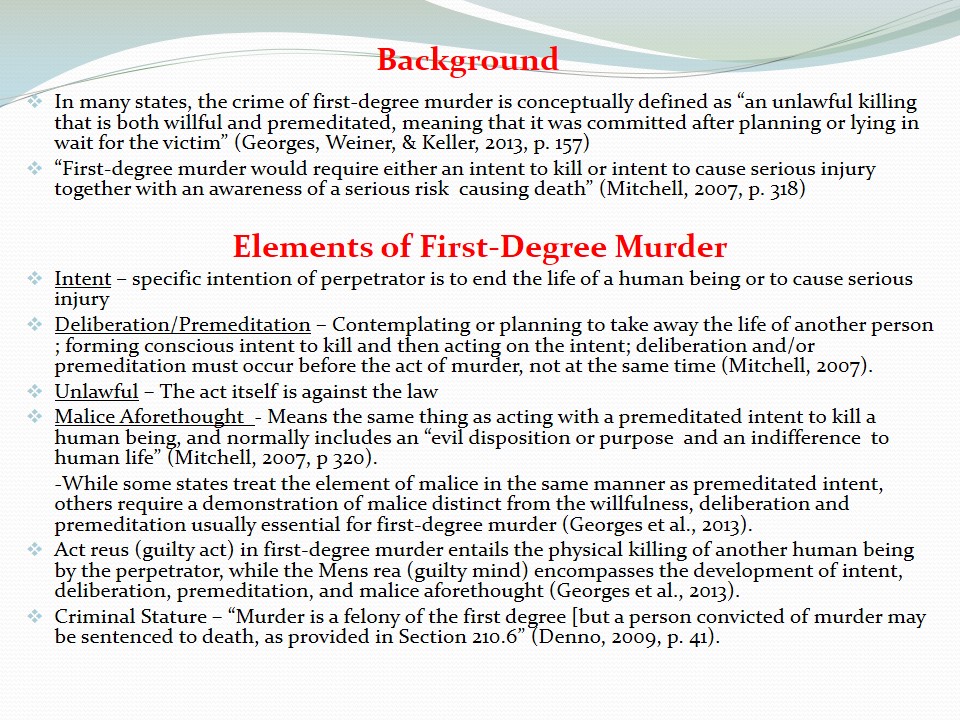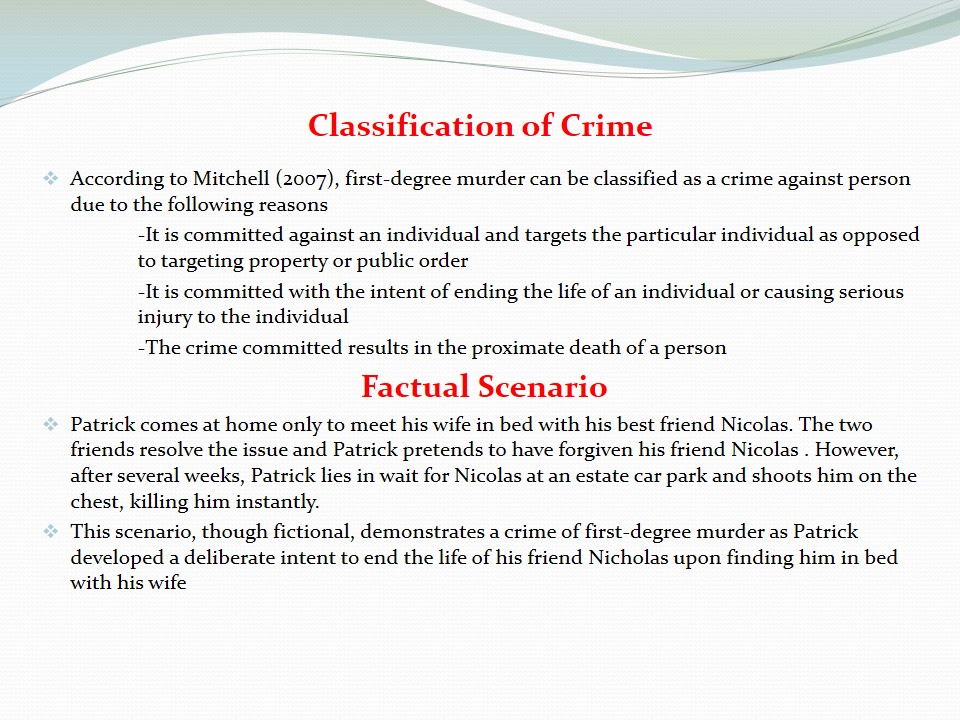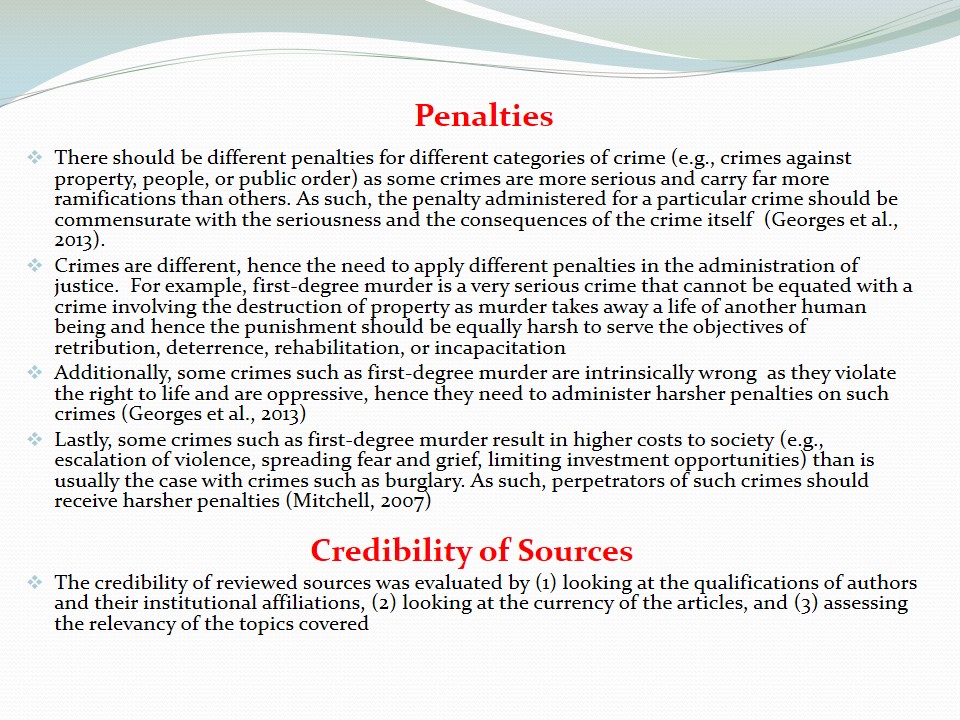Background
In many states, the crime of first-degree murder is conceptually defined as “an unlawful killing that is both willful and premeditated, meaning that it was committed after planning or lying in wait for the victim” (Georges, Weiner, & Keller, 2013, p. 157).
“First-degree murder would require either an intent to kill or intent to cause serious injury together with an awareness of a serious risk causing death” (Mitchell, 2007, p. 318).
Elements of First-Degree Murder
- Intent – specific intention of perpetrator is to end the life of a human being or to cause serious injury.
- Deliberation/Premeditation – Contemplating or planning to take away the life of another person ; forming conscious intent to kill and then acting on the intent; deliberation and/or premeditation must occur before the act of murder, not at the same time (Mitchell, 2007).
- Unlawful – The act itself is against the law.
- Malice Aforethought – Means the same thing as acting with a premeditated intent to kill a human being, and normally includes an “evil disposition or purpose and an indifference to human life” (Mitchell, 2007, p 320).
- While some states treat the element of malice in the same manner as premeditated intent, others require a demonstration of malice distinct from the willfulness, deliberation and premeditation usually essential for first-degree murder (Georges et al., 2013).
- Act reus (guilty act) in first-degree murder entails the physical killing of another human being by the perpetrator, while the Mens rea (guilty mind) encompasses the development of intent, deliberation, premeditation, and malice aforethought (Georges et al., 2013).
- Criminal Stature – “Murder is a felony of the first degree [but a person convicted of murder may be sentenced to death, as provided in Section 210.6” (Denno, 2009, p. 41).

Classification of Crime
According to Mitchell (2007), first-degree murder can be classified as a crime against person due to the following reasons:
- It is committed against an individual and targets the particular individual as opposed to targeting property or public order.
- It is committed with the intent of ending the life of an individual or causing serious injury to the individual.
- The crime committed results in the proximate death of a person.
Factual Scenario
Patrick comes at home only to meet his wife in bed with his best friend Nicolas. The two friends resolve the issue and Patrick pretends to have forgiven his friend Nicolas . However, after several weeks, Patrick lies in wait for Nicolas at an estate car park and shoots him on the chest, killing him instantly.
This scenario, though fictional, demonstrates a crime of first-degree murder as Patrick developed a deliberate intent to end the life of his friend Nicholas upon finding him in bed with his wife.

Penalties
There should be different penalties for different categories of crime (e.g., crimes against property, people, or public order) as some crimes are more serious and carry far more ramifications than others. As such, the penalty administered for a particular crime should be commensurate with the seriousness and the consequences of the crime itself (Georges et al., 2013).
Crimes are different, hence the need to apply different penalties in the administration of justice. For example, first-degree murder is a very serious crime that cannot be equated with a crime involving the destruction of property as murder takes away a life of another human being and hence the punishment should be equally harsh to serve the objectives of retribution, deterrence, rehabilitation, or incapacitation.
Additionally, some crimes such as first-degree murder are intrinsically wrong as they violate the right to life and are oppressive, hence they need to administer harsher penalties on such crimes (Georges et al., 2013).
Lastly, some crimes such as first-degree murder result in higher costs to society (e.g., escalation of violence, spreading fear and grief, limiting investment opportunities) than is usually the case with crimes such as burglary. As such, perpetrators of such crimes should receive harsher penalties (Mitchell, 2007).
Credibility of Sources
The credibility of reviewed sources was evaluated by
- looking at the qualifications of authors and their institutional affiliations,
- looking at the currency of the articles, and
- assessing the relevancy of the topics covered. .

References
Denno, D.W. (2009). Selected model penal code provisions. Web.
Georges, L.C., Weiner, R.F., & Keller, S.R. (2013). The angry juror: Sentencing decisions in first degree murder. Applied Cognitive Psychology, 27(2), 156-166.
Mitchell, B. (2007). Distinguishing between murder and manslaughter in practice. Journal of Criminal Law, 71(4), 318-341.